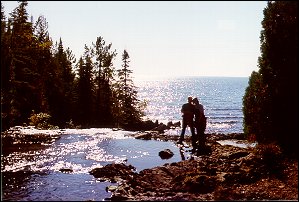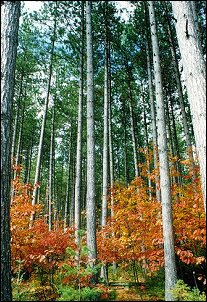
Where forest & forestry resources come together
for all users!
![]()
|
|
|
 Essays
to Consider When Learning About Forestry
Essays
to Consider When Learning About Forestry
Many times, a context or frame-of-reference must be established to better appreciate information presented to us. The following four essays provide illuminating perspectives about forests, forestry, and wood products that do not often effectively surface in enviromental debates. Every once in awhile, an author scribes an article that trancends political trends and popular media. These essays are samples of those sort of writings that help us set back and say "ah . . . now that makes sense."
 Dr.
Jim Bowyer, University of Minnesota, writes authoritatively about the wisdom
of using products made from wood, especially in comparision to products made
from other common raw materials such as metal, concrete, and plastic. His reasoning
and science are compelling. (53 kb pdf file)
Dr.
Jim Bowyer, University of Minnesota, writes authoritatively about the wisdom
of using products made from wood, especially in comparision to products made
from other common raw materials such as metal, concrete, and plastic. His reasoning
and science are compelling. (53 kb pdf file)
Dr. W.C. Lowdermilk, former assistant chief of the Soil Conservation Service, toured a number of regions throughout the world researching and observing countries where agriculture has been practiced for hundreds (or thousands) of years. The role of natural systems, especially soils and forests, becomes clearly pivotal in the success and failure of cultures and economies. (2.7 mb pdf file)
Dr. Patrick Moore, an environmentalist from Greenspirit [http://www.greenspirit.com/home.cfm], was one of the founders of Greenpeace. He has grown into an advocate of forests and forest management for sound environmental reasons and has a clever, and sometimes provocative, way of exposing some of the myths about forestry. (60 kb pdf file)
Don Smith, Connecticut State Forester, spoke at the National Association of State Foresters meeting in 2005. He stepped away from the usual reports and presentations and offered a historical perspective with a philosophical blend, and challenged society to recognize a natural resource that we, far too often, take for granted. (43 kb pdf file)
Of course, there are many other essays and books along these lines. For example, anyone interested in natural resource management, especially forestry and wildlife, should read Aldo Leopold's book "A Sand County Almanac." The almanac portion of the book provides rich and eloquent reading. The latter essays speak more to conservation, environmental ethics, and challenges to the natural resource profession that remain poignant over 50 years later.
 Michigan State
University is an affirmative action equal opportunity institution. The U.S.
Department of Agriculture prohibits discrimination on the basis of race, color,
national origin, gender, religion, age, disability, political beliefs, sexual
orientation, and marital status or family status. (Not all prohibited bases
apply to all programs.)
Michigan State
University is an affirmative action equal opportunity institution. The U.S.
Department of Agriculture prohibits discrimination on the basis of race, color,
national origin, gender, religion, age, disability, political beliefs, sexual
orientation, and marital status or family status. (Not all prohibited bases
apply to all programs.)